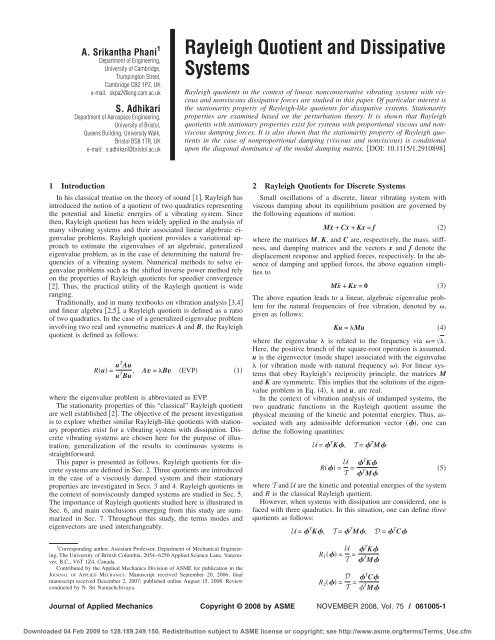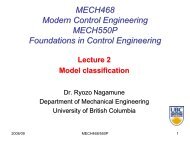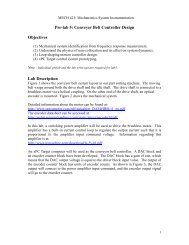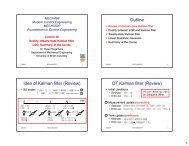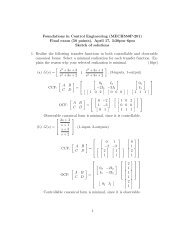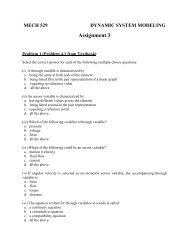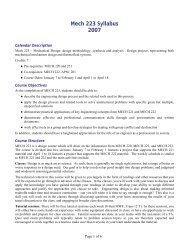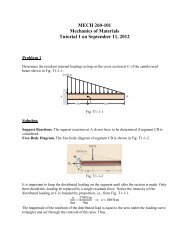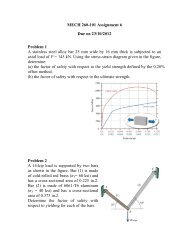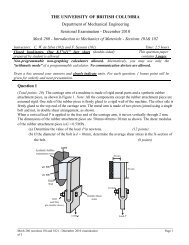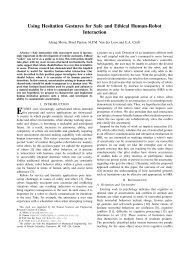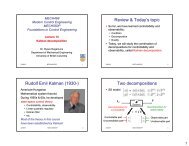Rayleigh Quotient and Dissipative Systems - UBC Mechanical ...
Rayleigh Quotient and Dissipative Systems - UBC Mechanical ...
Rayleigh Quotient and Dissipative Systems - UBC Mechanical ...
Create successful ePaper yourself
Turn your PDF publications into a flip-book with our unique Google optimized e-Paper software.
A. Srikantha Phani 1<br />
Department of Engineering,<br />
University of Cambridge,<br />
Trumpington Street,<br />
Cambridge CB2 1PZ, UK<br />
e-mail: skpa2@eng.cam.ac.uk<br />
S. Adhikari<br />
Department of Aerospace Engineering,<br />
University of Bristol,<br />
Queens Building, University Walk,<br />
Bristol BS8 1TR, UK<br />
e-mail: s.adhikari@bristol.ac.uk<br />
<strong>Rayleigh</strong> <strong>Quotient</strong> <strong>and</strong> <strong>Dissipative</strong><br />
<strong>Systems</strong><br />
<strong>Rayleigh</strong> quotients in the context of linear, nonconservative vibrating systems with viscous<br />
<strong>and</strong> nonviscous dissipative forces are studied in this paper. Of particular interest is<br />
the stationarity property of <strong>Rayleigh</strong>-like quotients for dissipative systems. Stationarity<br />
properties are examined based on the perturbation theory. It is shown that <strong>Rayleigh</strong><br />
quotients with stationary properties exist for systems with proportional viscous <strong>and</strong> nonviscous<br />
damping forces. It is also shown that the stationarity property of <strong>Rayleigh</strong> quotients<br />
in the case of nonproportional damping (viscous <strong>and</strong> nonviscous) is conditional<br />
upon the diagonal dominance of the modal damping matrix. DOI: 10.1115/1.2910898<br />
1 Introduction<br />
In his classical treatise on the theory of sound 1, <strong>Rayleigh</strong> has<br />
introduced the notion of a quotient of two quadratics representing<br />
the potential <strong>and</strong> kinetic energies of a vibrating system. Since<br />
then, <strong>Rayleigh</strong> quotient has been widely applied in the analysis of<br />
many vibrating systems <strong>and</strong> their associated linear algebraic eigenvalue<br />
problems. <strong>Rayleigh</strong> quotient provides a variational approach<br />
to estimate the eigenvalues of an algebraic, generalized<br />
eigenvalue problem, as in the case of determining the natural frequencies<br />
of a vibrating system. Numerical methods to solve eigenvalue<br />
problems such as the shifted inverse power method rely<br />
on the properties of <strong>Rayleigh</strong> quotients for speedier convergence<br />
2. Thus, the practical utility of the <strong>Rayleigh</strong> quotient is wide<br />
ranging.<br />
Traditionally, <strong>and</strong> in many textbooks on vibration analysis 3,4<br />
<strong>and</strong> linear algebra 2,5, a <strong>Rayleigh</strong> quotient is defined as a ratio<br />
of two quadratics. In the case of a generalized eigenvalue problem<br />
involving two real <strong>and</strong> symmetric matrices A <strong>and</strong> B, the <strong>Rayleigh</strong><br />
quotient is defined as follows:<br />
Ru = uT Au<br />
u T , Av = Bv EVP 1<br />
Bu<br />
where the eigenvalue problem is abbreviated as EVP.<br />
The stationarity properties of this “classical” <strong>Rayleigh</strong> quotient<br />
are well established 2. The objective of the present investigation<br />
is to explore whether similar <strong>Rayleigh</strong>-like quotients with stationary<br />
properties exist for a vibrating system with dissipation. Discrete<br />
vibrating systems are chosen here for the purpose of illustration;<br />
generalization of the results to continuous systems is<br />
straightforward.<br />
This paper is presented as follows. <strong>Rayleigh</strong> quotients for discrete<br />
systems are defined in Sec. 2. Three quotients are introduced<br />
in the case of a viscously damped system <strong>and</strong> their stationary<br />
properties are investigated in Secs. 3 <strong>and</strong> 4. <strong>Rayleigh</strong> quotients in<br />
the context of nonviscously damped systems are studied in Sec. 5.<br />
The importance of <strong>Rayleigh</strong> quotients studied here is illustrated in<br />
Sec. 6, <strong>and</strong> main conclusions emerging from this study are summarized<br />
in Sec. 7. Throughout this study, the terms modes <strong>and</strong><br />
eigenvectors are used interchangeably.<br />
1 Corresponding author. Assistant Professor, Department of <strong>Mechanical</strong> Engineering,<br />
The University of British Columbia, 2054–6250 Applied Science Lane, Vancouver,<br />
B.C., V6T 1Z4, Canada.<br />
Contributed by the Applied Mechanics Division of ASME for publication in the<br />
JOURNAL OF APPLIED MECHANICS. Manuscript received September 20, 2006; final<br />
manuscript received December 2, 2007; published online August 15, 2008. Review<br />
conducted by N. Sri Namachchivaya.<br />
2 <strong>Rayleigh</strong> <strong>Quotient</strong>s for Discrete <strong>Systems</strong><br />
Small oscillations of a discrete, linear vibrating system with<br />
viscous damping about its equilibrium position are governed by<br />
the following equations of motion:<br />
Mẍ + Cẋ + Kx = f<br />
2<br />
where the matrices M, K, <strong>and</strong> C are, respectively, the mass, stiffness,<br />
<strong>and</strong> damping matrices <strong>and</strong> the vectors x <strong>and</strong> f denote the<br />
displacement response <strong>and</strong> applied forces, respectively. In the absence<br />
of damping <strong>and</strong> applied forces, the above equation simplifies<br />
to<br />
Mẍ + Kx = 0<br />
3<br />
The above equation leads to a linear, algebraic eigenvalue problem<br />
for the natural frequencies of free vibration, denoted by ,<br />
given as follows:<br />
Ku = Mu<br />
4<br />
where the eigenvalue is related to the frequency via = .<br />
Here, the positive branch of the square-root operation is assumed.<br />
u is the eigenvector mode shape associated with the eigenvalue<br />
or vibration mode with natural frequency . For linear systems<br />
that obey <strong>Rayleigh</strong>’s reciprocity principle, the matrices M<br />
<strong>and</strong> K are symmetric. This implies that the solutions of the eigenvalue<br />
problem in Eq. 4, <strong>and</strong> u, are real.<br />
In the context of vibration analysis of undamped systems, the<br />
two quadratic functions in the <strong>Rayleigh</strong> quotient assume the<br />
physical meaning of the kinetic <strong>and</strong> potential energies. Thus, associated<br />
with any admissible deformation vector , one can<br />
define the following quantities:<br />
U = T K, T = T M<br />
R = U T = T K<br />
T 5<br />
M<br />
where T <strong>and</strong> U are the kinetic <strong>and</strong> potential energies of the system<br />
<strong>and</strong> R is the classical <strong>Rayleigh</strong> quotient.<br />
However, when systems with dissipation are considered, one is<br />
faced with three quadratics. In this situation, one can define three<br />
quotients as follows:<br />
U = T K, T = T M, D = T C<br />
R 1 = U T = T K<br />
T M<br />
R 2 = D T = T C<br />
T M<br />
Journal of Applied Mechanics Copyright © 2008 by ASME NOVEMBER 2008, Vol. 75 / 061005-1<br />
Downloaded 04 Feb 2009 to 128.189.249.150. Redistribution subject to ASME license or copyright; see http://www.asme.org/terms/Terms_Use.cfm
R 3 = D U = T C<br />
T 6<br />
K<br />
Note that for <strong>Rayleigh</strong> quotient to be finite, the denominator terms<br />
in the above equation should not be equal to zero. This requires<br />
that M be positive definite for R 1 <strong>and</strong> R 2 to be finite, <strong>and</strong> K be<br />
positive definite for R 3 to be finite. For majority of vibrating systems,<br />
M is positive definite while K need not be. Thus, the existence<br />
of R 3 is case specific.<br />
It is the objective of this work to investigate the stationarity<br />
properties of the quotients defined in Eqs. 5 <strong>and</strong> 6. The proof<br />
of stationary property of the quotient defined in Eq. 5 is well<br />
known 2,5,6. However, it is repeated here for the sake of completeness<br />
<strong>and</strong> also since the proof of stationarity for other quotients<br />
closely follows a similar procedure.<br />
2.1 Stationarity of R„…. Let a vector be chosen such that<br />
it is close to one of the eigenvectors modes u r of the system so<br />
that we can express as<br />
= c i u i = u r +<br />
i<br />
i u i , i = c i<br />
≪ 1 7<br />
ir<br />
c r<br />
where i is a small real quantity. Now, the <strong>Rayleigh</strong> quotient reads<br />
R = T K<br />
T M = u r T Ku r +2 ir i u i T Ku r + O 2 <br />
u r T Mu r +2 ir i u i T Mu r + O 2 <br />
here, the symmetry of M <strong>and</strong> K is assumed. Due to the orthogonality<br />
properties of the eigenvectors 2,5,<br />
u T i Mu j = ij , u T i Ku j =0, u T i Ku i = i 9<br />
Equation 8 simplifies to<br />
R = r + O 2 <br />
1+O 2 = r1+O 2 10<br />
The above result proves the stationarity of the <strong>Rayleigh</strong> quotient,<br />
i.e., first order changes in lead to second order changes in R.<br />
When is close to one of the eigenvectors, the corresponding<br />
value of the quotient is stationary. Further choosing the first eigenvector<br />
as the trial vector leads to a minimum value of R.<br />
R is maximum when the trial vector is close to the eigenvector<br />
corresponding to the highest eigenvalue. For intermediate eigenvectors,<br />
R is neither a minimum nor a maximum, i.e., R is<br />
at a saddle point. A mini-max or inf-sup principle due to Courant<br />
<strong>and</strong> Fischer applies in this case 2,6.<br />
3 Proportional Damping<br />
We consider first the case of proportional damping. Here, proportional<br />
damping is defined in the sense that the same vector <br />
simultaneously diagonalizes the three quadratics T, U, <strong>and</strong> D. In<br />
other words, the three matrices M, K, <strong>and</strong> C can be simultaneously<br />
diagonalized. Although a viscous damping matrix of the<br />
form C=M+K is the most widely understood model of a proportional<br />
damping model, it is only a subset of a wider class of<br />
models 7. The necessary <strong>and</strong> sufficient conditions for proportional<br />
damping are established in Ref. 7 <strong>and</strong> revisited in Refs.<br />
8–11. Adhikari 10 showed that viscously damped linear systems<br />
will have classical normal modes if <strong>and</strong> only if the damping<br />
matrix can be represented by<br />
a C=M 1 M −1 K+K 2 K −1 M<br />
or<br />
b C= 3 KM −1 M+ 4 MK −1 K<br />
where i • are smooth analytic functions in the neighborhood of<br />
all the eigenvalues of their argument matrices. <strong>Rayleigh</strong>’s result<br />
can be obtained directly from this “generalized proportional<br />
8<br />
damping” as a special case by choosing each matrix function i •<br />
as a real scalar times an identity matrix, that is i •= i I.Inthe<br />
case of proportionally damped systems, the eigenvectors are real<br />
but the eigenvalues are not, i.e., the undamped modes are also the<br />
modes of the proportionally damped system. Thus, the proof of<br />
stationarity of the first <strong>Rayleigh</strong> quotient R 1 is the same as that<br />
given in Sec. 2.1.<br />
We consider the second <strong>Rayleigh</strong> quotient associated with any<br />
admissible deformation vector as defined in Eq. 7,<br />
R 2 = T C<br />
T M = u r T Cu r +2 ir i u i T Cu r + O 2 <br />
u r T Mu r +2 ir i u i T Mu r + O 2 <br />
11<br />
here, the symmetry of M <strong>and</strong> C is assumed. Due to the orthogonality<br />
properties of the eigenvectors,<br />
u T i Mu j = ij<br />
12<br />
We define<br />
u T i Cu j = C ij , u T i Cu i = C ii <br />
13<br />
With the above definition, Eq. 11 can be expressed as<br />
R 2 = C rr +2 ir i C ir + O 2 <br />
1+O 2 14<br />
<br />
When damping is proportional, the matrix C ir is diagonal, i.e.,<br />
C ir =0 for ir. In this case, the above equation simplifies to<br />
R 2 = C rr + O 2 <br />
1+O 2 = C<br />
rr 1+O 2 15<br />
which proves the stationarity of <strong>Rayleigh</strong> quotient in the case of a<br />
proportionally damped system.<br />
Similar proof can be constructed for R 3 . The equation corresponding<br />
to Eq. 15 in this case will read as<br />
R 3 = C rr + O 2 <br />
2 r + O 2 = C rr <br />
2<br />
1+O2 16<br />
r<br />
4 Nonproportional Damping<br />
We consider the case of nonproportional damping wherein the<br />
damping matrix C cannot be diagonalized simultaneously with M<br />
<strong>and</strong> K matrices. Consequently, the vector is not necessarily real.<br />
Vibrating systems with nonproportional damping are known to<br />
possess complex modes in general. Physically, the complex modes<br />
represent nearly st<strong>and</strong>ing waves. For systems with small dissipation,<br />
a perturbation theory originally due to <strong>Rayleigh</strong> 1 can be<br />
used to represent the complex modes in terms of the real modes of<br />
the undamped system.<br />
According to the first order perturbation theory 12, the complex<br />
modes of a viscously damped system are related to the corresponding<br />
undamped modes by<br />
z n u n + ı<br />
kn<br />
kn u k<br />
where kn = nC<br />
kn<br />
2 2<br />
n − 1<br />
k<br />
17<br />
The undamped modes are mass normalized i.e., u T n Mu n =1.Inthe<br />
above equation, C is the damping matrix in modal coordinates,<br />
i.e., C kn =u T k Cu n . The assumption in the perturbation theory is that<br />
the terms of the order 2 kn are very small <strong>and</strong> hence negligible.<br />
When k <strong>and</strong> n refer to two adjacent modes, the coefficient kn<br />
can be related to the modal overlap factor defined as kn<br />
n n / k − n <strong>and</strong> the ratio kn =C kn /C nn by kn<br />
1/2 kn kn . Notice that kn is a measure of the diagonal dominance<br />
of the C matrix. kn is a measure of the spacing of adjacent<br />
modes normalized with respect to the half power b<strong>and</strong>width<br />
of each mode. Thus, significantly complex modes are to be expected<br />
when the modal damping matrix is not diagonally domi-<br />
061005-2 / Vol. 75, NOVEMBER 2008 Transactions of the ASME<br />
Downloaded 04 Feb 2009 to 128.189.249.150. Redistribution subject to ASME license or copyright; see http://www.asme.org/terms/Terms_Use.cfm
nant <strong>and</strong> the modal overlap is not small. Unless the modal overlap<br />
factor is of the order of unity, the second <strong>and</strong> higher order powers<br />
of the kn can be safely ignored. If not, then the perturbation<br />
expansion has to be extended suitably until the imaginary part of<br />
the complex mode converges. Adequacy of the first order theory<br />
for systems with small damping has been shown in Ref. 12.<br />
Since the complex eigenvectors z i , i=1¯n form the complete<br />
basis in an n dimensional complex vector space, any arbitrary<br />
complex vector can be written as<br />
= c i z i<br />
i<br />
We select a vector close to z r , which can be written as<br />
= z r + i z i ,<br />
ir<br />
i = c i<br />
c r 1.<br />
18<br />
19<br />
We consider the first real valued <strong>Rayleigh</strong> quotient associated<br />
with the above trial vector,<br />
R 1 = H K<br />
H M = z r H Kz r +2 ir R i z i H Kz r + O 2 <br />
z r H Mz r +2 ir R i z i H Mz r + O 2 <br />
20<br />
Noting the orthogonality properties given in Eq. 9, one can deduce<br />
the following equations:<br />
<strong>and</strong><br />
z r H Mz r =1+O 2 <br />
z H i Mz r = O 2 <br />
Similarly with K, one can show<br />
<strong>and</strong><br />
z r H Kz r = r 2 + O 2 <br />
21<br />
22<br />
23<br />
z H i Kz r = O 2 <br />
24<br />
Substituting Eqs. 21–24 in Eq. 20, one obtains<br />
R 1 = 2 r + O 2 + O 2 <br />
1+O 2 + O 2 2 r1−O 2 25<br />
which proves the stationarity of R 1 .<br />
We consider the second real valued <strong>Rayleigh</strong> quotient defined<br />
as follows:<br />
R 2 = zH Cz<br />
z H 26<br />
Mz<br />
Substituting Eq. 17 in the above equation leads to<br />
R 2 = H C<br />
H M = z r H Cz r +2 ir R i z i H Cz r + O 2 <br />
z r H Mz r +2 ir R i z i H Mz r + O 2 <br />
Now z r H Cz r can be exp<strong>and</strong>ed as<br />
z r H Cz r =<br />
u r T − ı kr u k<br />
T<br />
kr<br />
C u r + ı <br />
kr<br />
kr u k<br />
= C rr − ı kr u T k Cu r − u T r Cu k + O 2 = C rr + O 2 <br />
kr<br />
27<br />
28<br />
Note that C is assumed to be symmetric in simplifying the above<br />
equation. Similarly, one can write<br />
z H i Cz r = u i T − ı ki u k<br />
T C u r + ı<br />
ki<br />
kr u<br />
kr<br />
k<br />
= C ir − ı ki C kr + ı<br />
ki<br />
kr C ik + O 2 <br />
kr<br />
= C ir + O + O 2 <br />
29<br />
Substituting Eqs. 21 <strong>and</strong> 22, <strong>and</strong> Eqs. 28 <strong>and</strong> 29 in Eq. 27,<br />
one obtains<br />
C rr +2 ir R i C ir + OO + O 2 + O 2 <br />
R 2 =<br />
1+O 2 + O 2 <br />
30<br />
It can be seen that first order changes in lead to first order<br />
changes in R 2 . However, if the modal damping matrix is diagonally<br />
dominant, i.e.,<br />
C ir <br />
C rr 1<br />
31<br />
then first order changes in lead to second order changes in<br />
R 2 . In this case, stationarity of the <strong>Rayleigh</strong> quotient is obtained.<br />
Returning to the third quotient R 3 ,<br />
R 3 = H C<br />
H K<br />
C rr +2 ir R i C ir + OO + O 2 + O 2 <br />
=<br />
2 r + O 2 + O 2 <br />
32<br />
The above quotient is not stationary in general. However, when<br />
the modal damping matrix is diagonally dominant in accordance<br />
with Eq. 31, stationarity of R 3 can be shown as earlier see<br />
Sec. 3.<br />
In the case of a complex vector , one is also tempted to define<br />
complex valued <strong>Rayleigh</strong> quotients by replacing the Hermitian<br />
transpose complex conjugate transpose with the ordinary transpose<br />
operator. The stationarity property of these complex valued<br />
quotients, however, cannot be shown. Hence, the discussion of<br />
these quotients will not be pursued any further.<br />
5 Nonviscous Damping<br />
In this section, we consider general linear damping models,<br />
described by convolution integrals of the generalized coordinates<br />
over appropriate kernel functions. The equation of motion of a N<br />
degrees-of-freedom nonviscously damped system is given by<br />
t<br />
Mẍt Gt − ẋd + Kxt = ft 33<br />
+−<br />
Here, Gt is a NN matrix of kernel functions. It will be assumed<br />
that Gt is a symmetric matrix so that reciprocity automatically<br />
holds. In the special case when Gt=Ct, where t<br />
is the Dirac delta function <strong>and</strong> C is a NN matrix, Eq. 33<br />
reduces to the st<strong>and</strong>ard form for viscous damping.<br />
Taking the Fourier transform of Eq. 33, the eigenvalue equation<br />
can be expressed as<br />
− 2 n Mz n + ı n G n z n + Kz n = 0<br />
34<br />
where G is the Fourier transform of Gt. In general, G is a<br />
complex valued function of . For viscously damped system,<br />
G=C, ∀. Equation 34 is a nonlinear eigenvalue problem. In<br />
contrast with the viscously damped case, the number of eigenvalues<br />
will not necessarily be equal to 2N, since additional eigenvalues<br />
may be introduced by the form of the functions G n . Wood-<br />
Journal of Applied Mechanics NOVEMBER 2008, Vol. 75 / 061005-3<br />
Downloaded 04 Feb 2009 to 128.189.249.150. Redistribution subject to ASME license or copyright; see http://www.asme.org/terms/Terms_Use.cfm
house 12 <strong>and</strong> Adhikari 13 have treated this problem using a<br />
first order perturbation method assuming the damping to be small.<br />
We suppose the undamped problem has eigenvalues natural frequencies<br />
n <strong>and</strong> eigenvectors modes u n . The complex eigenvalues<br />
can then be expressed as<br />
n n + ıG nn n /2<br />
35<br />
where G kl n =u T k G n u l is the frequency dependent damping<br />
matrix expressed in normal coordinates. Since the inverse Fourier<br />
transform of G must be real, it must satisfy the condition<br />
G−=G*, where •* denotes complex conjugation. It follows<br />
that the eigenvalues of the generally damped system appear<br />
in pairs <strong>and</strong> −* unless is purely imaginary. The first order<br />
approximate expression for the complex eigenvectors can be obtained<br />
in a way similar to that used for the viscously damped<br />
system as was first given by <strong>Rayleigh</strong> 1. The result is<br />
z n u n + ı<br />
kn<br />
kn u k<br />
where kn = nG kn n <br />
2 n − 2 k <br />
36<br />
Note that the eigenvectors also appear in complex conjugate pairs.<br />
Since, in general, G kn n will be complex, in contrast to the<br />
viscously damped case, the real part of natural frequencies <strong>and</strong><br />
mode shapes do not coincide with the undamped ones. Adequacy<br />
of the first order theory for systems with small damping has been<br />
investigated in Refs. 12,13.<br />
Since the complex eigenvectors z i ,i=1¯N form the complete<br />
basis of an N-dimensional complex vector space, any arbitrary<br />
complex vector can be expressed as<br />
= c i z i<br />
37<br />
i<br />
We consider a vector close to z r , which can be written as<br />
= z r + i z i ,<br />
ir<br />
i = c i<br />
c r 1<br />
38<br />
Replacing the matrix G r with M <strong>and</strong> noting the orthogonality<br />
properties given in Eq. 9, one obtains<br />
of frequency. Therefore, in order to define a meaningful <strong>Rayleigh</strong><br />
quotient, we need to select a value of frequency. If we are interested<br />
in studying the stationary behavior of rth mode, then it is<br />
logical to select the frequency value as r . We define the real<br />
valued <strong>Rayleigh</strong> quotient for a nonviscously damped system as<br />
R 2 , r = H G r <br />
H M<br />
45<br />
For a viscously damped system G r =C, ∀r <strong>and</strong> because C is a<br />
real matrix, Eq. 45 reduces to Eq. 26 as a special case. Therefore,<br />
Eq. 45 can be viewed as a generalization of the <strong>Rayleigh</strong><br />
quotient defined in Eq. 26.<br />
Substituting Eq. 36 in the above equation leads to<br />
R 2 = H G r <br />
H M<br />
z H r G r z r +2 ir R i z H i G r z r + O 2 <br />
=<br />
z H r Mz r +2 ir R i z H i Mz r + O 2 <br />
The first term in numerator can be expressed as<br />
z H r G r z r = u r T − ı * kr<br />
u k<br />
T r G u r + ı<br />
kr<br />
kr u<br />
kr<br />
k<br />
= u T r G r u r − ı * kr<br />
− kr u T k G r u r<br />
kr<br />
− u r T G r u k + O 2 <br />
46<br />
Similarly with K, one obtains<br />
z r H Mz r =1+O 2 <br />
z i H Mz r = O 2 <br />
39<br />
40<br />
= G rr +2ı I kr u T k G r u r<br />
kr<br />
− u T r G r u k + O 2 <br />
= G rr + OI + O 2 <br />
47<br />
z r H Kz r = r 2 + O 2 <br />
z H i Kz r = O 2 <br />
We consider the first <strong>Rayleigh</strong> quotient<br />
R 1 = H K<br />
H M = z r H Kz r +2 ir R i z i H Kz r + O 2 <br />
z r H Mz r +2 ir R i z i H Mz r + O 2 <br />
41<br />
42<br />
43<br />
Substituting Eqs. 39–42 in the above equation, one obtains<br />
R 1 = 2 r + O 2 + O 2 <br />
1+O 2 + O 2 2 r1−O 2 44<br />
which proves the stationarity of R 1 .<br />
The second <strong>and</strong> third <strong>Rayleigh</strong> quotients involving the damping<br />
term need to be carefully defined. The difference between the<br />
viscous <strong>and</strong> the nonviscous case is that the effective damping<br />
matrix for the nonviscous case is complex valued <strong>and</strong> a function<br />
where G rr =u T r G r u r . Note that G r is assumed to be symmetric<br />
in simplifying the above equation. From the second term in the<br />
numerator of Eq. 46, one has<br />
z H i G r z r = u i T − ı * ki<br />
u k<br />
T r G u r + ı<br />
ki<br />
kr u<br />
kr<br />
k<br />
= u T i G r u r − ı * ki<br />
u T k G r u r<br />
ki<br />
+ ı <br />
kr<br />
kr u i T G r u k + O 2 <br />
= G ir + O + O 2 <br />
48<br />
where G ir =u T i G r u r .<br />
Substituting Eqs. 47, 46, 45, 44, 43, 42, 41, <strong>and</strong> 40<br />
in Eq. 46, one obtains<br />
061005-4 / Vol. 75, NOVEMBER 2008 Transactions of the ASME<br />
Downloaded 04 Feb 2009 to 128.189.249.150. Redistribution subject to ASME license or copyright; see http://www.asme.org/terms/Terms_Use.cfm
G rr +2 ir R i G ir + OO + O 2 + OI + O 2 <br />
R 2 =<br />
1+O 2 + O 2 <br />
G rr +2 ir R i G ir + OO + O 2 + OI + O 2 <br />
1+O 2 + O 2 <br />
49<br />
The last line in the above equation follows from the triangle inequality.<br />
The terms involving OI are smaller than O<br />
terms. Moreover, for lightly nonviscous systems, the terms involving<br />
OI are expected to be smaller than the OR terms<br />
14. As a result, one expects to have the inequality<br />
OI OR O<br />
50<br />
From Eq. 49, it can be seen that first order changes in lead to<br />
first order changes in R 2 . However, if the complex modal<br />
damping matrix is diagonally dominant, i.e.,<br />
G ir <br />
G rr 1<br />
51<br />
then first order changes in lead to second order changes in<br />
R 2 . In this case, stationarity of the <strong>Rayleigh</strong> quotient is<br />
obtained.<br />
Returning to the third quotient, the equation corresponding to<br />
Eq. 46 in the case of R 3 is<br />
R 3 = H G r <br />
H K<br />
G rr +2 ir R i G ir + OO + O 2 + OI + O 2 <br />
2 r + O 2 + O 2 <br />
52<br />
The above quotient is not stationary. However, when the modal<br />
damping matrix is diagonally dominant in accordance with Eq.<br />
31, stationarity of R 3 holds.<br />
6 Application of <strong>Rayleigh</strong> <strong>Quotient</strong>s<br />
In the case of a single degree of freedom system with viscous<br />
damping the three quotients simplify to R 1 = 2 , R 2 =2, <strong>and</strong><br />
R 3 =2/, where <strong>and</strong> denote the natural frequency <strong>and</strong> the<br />
critical damping factor, respectively. The response of the system<br />
in the time domain is described by exp−t−ı 1− 2 t. We<br />
note that R 2 governs the decay rate or real part of the complex<br />
eigenvalue of vibration in the time domain. The same will be true<br />
for a multidegree of freedom system, provided that its response<br />
can be decomposed into a single degree of freedom system using<br />
modal summation i.e., damping is proportional 3.<br />
The <strong>Rayleigh</strong> quotient R 1 <strong>and</strong> its usefulness in solving the eigenvalue<br />
problem associated with the undamped system are well<br />
documented 2,3,5. Consequent to the stationary property of R 1 ,a<br />
theorem originally due to <strong>Rayleigh</strong>, known as <strong>Rayleigh</strong>’s principle<br />
or interlacing theorem, gives the influence of constraints. It states<br />
that the eigenvalues of the constrained system interlace with<br />
the eigenvalues of the unconstrained system such that n<br />
n n+1 .<br />
Similar results follow from the stationarity of R 2 <strong>and</strong> R 3 . In this<br />
context, we refer to <strong>Rayleigh</strong>’s original statement in Sec. 88 of<br />
Ref. 1: “… theorems, of importance in other branches of science,<br />
may be stated for systems such that only T <strong>and</strong> F, or only V<br />
<strong>and</strong> F, are sensible.” We note that TT, VU, <strong>and</strong> FD in the<br />
notation of the present paper. Thus, stationarity of R 2 implies that<br />
the decay rates of each normal mode are stationary. The interlacing<br />
theorem would suggest that the decay rates of each normal<br />
mode also interlace when a constraint is applied. The interlacing<br />
property was discussed in Sec. 88 of Ref. 1 <strong>and</strong> a less known<br />
work of <strong>Rayleigh</strong> 15. The present study extends these ideas to<br />
the general case of nonconservative systems with viscous or nonviscous<br />
dissipative processes.<br />
In a viscoelastic system, one deals with elastic potentials <strong>and</strong><br />
dissipative potentials. Stationarity of R 3 has important consequences<br />
for such problems, especially in conjunction with the<br />
interlacing theorem. A noteworthy work on applying the <strong>Rayleigh</strong><br />
quotients to determine the elastic <strong>and</strong> material loss constants of<br />
orthotropic sheet materials was undertaken in Refs. 16,17.<br />
Our primary aim in this work has been to show the range of<br />
applicability of stationarity principles in nonconservative viscous<br />
<strong>and</strong> nonviscous systems. Further application of these results remains<br />
to be explored in future studies.<br />
7 Conclusions<br />
<strong>Rayleigh</strong> quotients are revisited in the context of dissipative<br />
systems. The study of their stationarity properties leads to the<br />
following conclusions.<br />
1. In the case of a proportionally damped viscous system, the<br />
three <strong>Rayleigh</strong> quotients associated with the damped system<br />
are stationary.<br />
2. In the case of a nonproportionally damped system, the <strong>Rayleigh</strong><br />
quotient involving mass <strong>and</strong> stiffness matrix is stationary<br />
while the remaining two involving damping matrix are<br />
not. Stationarity in this case is subject to the diagonal dominance<br />
of the modal damping matrix. For an arbitrarily chosen<br />
viscous damping matrix, the stationarity property does<br />
not hold true. However, this negative conclusion is to be<br />
balanced by the wide variety of practical engineering structures<br />
where the modal damping is diagonally dominant; consequently,<br />
<strong>Rayleigh</strong> quotients are stationary.<br />
3. In the case of a nonviscously damped system, the <strong>Rayleigh</strong><br />
quotient involving mass <strong>and</strong> stiffness matrix is still stationary<br />
while the remaining two involving the frequency dependent<br />
damping matrix are not. Stationarity in this case is subject<br />
to a the diagonal dominance of the absolute value of<br />
the frequency dependent complex modal damping matrix,<br />
<strong>and</strong> b light nonviscous damping. For an arbitrarily chosen<br />
nonviscous damping function, the stationarity property does<br />
not hold true.<br />
Journal of Applied Mechanics NOVEMBER 2008, Vol. 75 / 061005-5<br />
Downloaded 04 Feb 2009 to 128.189.249.150. Redistribution subject to ASME license or copyright; see http://www.asme.org/terms/Terms_Use.cfm
Acknowledgment<br />
A.S.P. acknowledges financial support from Cambridge Commonwealth<br />
Trust <strong>and</strong> Nehru Trust for Cambridge University<br />
through the award of Nehru Fellowship; ORS award from CVCP,<br />
UK; <strong>and</strong> Bursaries from St. John’s college, Cambridge, UK. S.A.<br />
acknowledges the support of the UK Engineering <strong>and</strong> Physical<br />
Sciences Research Council EPSRC through the award of an Advanced<br />
Research Fellowship, Grant No. GR/T03369/01.<br />
References<br />
1 <strong>Rayleigh</strong>, J. W., 1894, The Theory of Sound, Dover, New York, Vol. 1.<br />
2 Strang, G., 1988, Linear Algebra <strong>and</strong> its Applications, 3rd ed., Hardcourt<br />
Brace Jovanovich, Orl<strong>and</strong>o, FL.<br />
3 Meirovitch, L., 1986, Elements of Vibration Analysis, 2nd ed., McGraw-Hill,<br />
New York.<br />
4 Newl<strong>and</strong>, D. E., 1990, <strong>Mechanical</strong> Vibration Analysis & Computation, rep.<br />
ed., Longmans, Green, New York.<br />
5 Wilkinson, J. H., 1965, The Algebraic Eigenvalue Problem, 1st ed., Clarendon,<br />
Oxford.<br />
6 Courant, R., <strong>and</strong> Hilbert, D., 1989, Methods of Mathematical Physics: Volume<br />
1, 1st ed., Wiley, New York.<br />
7 Caughey, T. K., <strong>and</strong> O’Kelly, M. E. J., 1965, “Classical Normal Modes in<br />
Damped Linear Dynamic <strong>Systems</strong>,” J. Appl. Mech., 32, pp. 583–588.<br />
8 Adhikari, S., 2001, “Classical Normal Modes in Non-Viscously Damped Linear<br />
<strong>Systems</strong>,” AIAA J., 395, pp. 978–980.<br />
9 Phani, A. S., 2003, “On the Necessary <strong>and</strong> Sufficient Conditions for the Existence<br />
of Classical Normal Modes in Damped Linear Dynamic <strong>Systems</strong>,” J.<br />
Sound Vib., 2643, pp. 741–745.<br />
10 Adhikari, S., 2006, “Damping Modelling Using Generalized Proportional<br />
Damping,” J. Sound Vib., 2931–2, pp. 156–170.<br />
11 Adhikari, S., <strong>and</strong> Phani, A., 2007, “Experimental Identification of Generalized<br />
Proportional Damping,” ASME J. Vibr. Acoust., to be published.<br />
12 Woodhouse, J., 1998, “Linear Damping Models for Structural Vibration,” J.<br />
Sound Vib., 2153, pp. 547–569.<br />
13 Adhikari, S., 2002, “Dynamics of Non-Viscously Damped Linear <strong>Systems</strong>,” J.<br />
Eng. Mech., 1283, pp. 328–339.<br />
14 Adhikari, S., <strong>and</strong> Woodhouse, J., 2003, “Quantification of Non-Viscous Damping<br />
in Discrete Linear <strong>Systems</strong>,” J. Sound Vib., 2603, pp. 499–518.<br />
15 <strong>Rayleigh</strong>, J. W., 1885, “A Theorem Relating to the Time-Moduli of <strong>Dissipative</strong><br />
<strong>Systems</strong>,” Report of the British Association, pp. 911–912.<br />
16 McIntyre, M. E., <strong>and</strong> Woodhouse, J., 1978, “The Influence of Geometry on<br />
Damping,” Acustica, 394, pp. 210–224.<br />
17 McIntyre, M. E., <strong>and</strong> Woodhouse, J., 1988, “On Measuring the Elastic <strong>and</strong><br />
Damping Constants of Orthotropic Sheet Materials,” Acta Metall., 366, pp.<br />
1397–1416.<br />
061005-6 / Vol. 75, NOVEMBER 2008 Transactions of the ASME<br />
Downloaded 04 Feb 2009 to 128.189.249.150. Redistribution subject to ASME license or copyright; see http://www.asme.org/terms/Terms_Use.cfm


